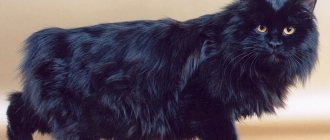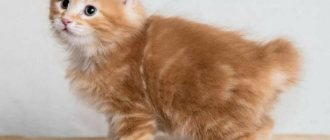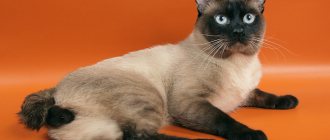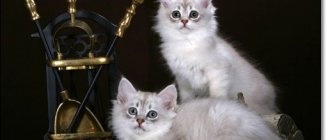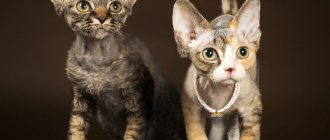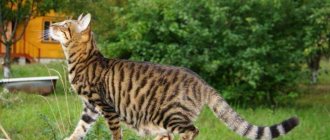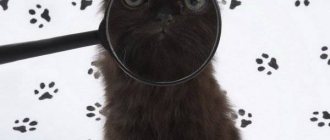Origin story
Karelian Bobtails are a native breed first discovered near Lake Ladoga.
Felinologists believe that their ancestors were the famous Norwegian cats - excellent hunters living in groups in the Karelian forests. For a long time they were considered relatives of the Kurilian Bobtail, but over time it became clear that from a genetic point of view, nothing connects them.
For the first time, Karelian bobtails were shown to the public at an exhibition in Leningrad, in 1987, at the request of the breeder Liliya Dvoryaninova. However, only in 1990 was a standard drawn up, and in 1994 they were officially included in the WCF register as one of the 3 officially recognized Russian breeds.
Description of the breed
The Karelian Bobtail is a medium-sized, compact cat with a short (4-13 cm) tail, which can have kinks and look like a “pompom”, or be almost straight - in this case, this length of the tail is achieved by reducing the vertebrae. The hind legs are noticeably longer than the front legs. The head is narrow, without cheeks, with a small strong chin and a straight, elongated profile, and the ears are quite large, with tiny but noticeable tufts. Karelian bobtails come in short-haired and semi-long-haired varieties.
They adapt perfectly to any living conditions, quickly get used to people, are smart and obedient. Their voice sounds like a kind of singing or chirping. Karelian bobtails in the wild live in prides, which implies a certain hierarchy and the need to get along with their relatives. Therefore, even at home, cats practically do not mark their territory.
Standards
These are compact, small cats, with an average weight of 3-5 kg (males are larger than females).
| Standard | Description |
| Head | With a wedge-shaped skull and large erect ears. The forehead is flat. The whisker pads are barely noticeable, the chin is strong and narrow. |
| Eyes | Medium size, oval, slightly slanted. |
| Torso | The limbs are slender and muscular. Paws are round, wide, with graceful toes. The back is straight, the croup is slightly raised. |
| Tail | Short and always straight, from 4 to 15 cm long. |
| Wool | Thick, shiny, dense, short undercoat. Long-haired bobtails have “pants” growing in the area of their hind legs, and a shirtfront on their neck. Short-haired cats have neither shirt-fronts nor “pants”, but the fur is even thicker and more beautiful. |
A curved tail, a round head, an overly long or short body are a serious fault.
Cat with a short tail: application, characteristics of the breed
A cat with a short tail is a favorite of many owners. The short tail of representatives of Karelian bobtails was formed in the process of natural evolution.
The gene responsible for the length of the tail is dominant in this case (unlike the Kurilian bobtail).
Cats with short tails initially evoked pity among people. But later it turned out that they were born that way. There is a legend that if kittens with long tails were born in the offspring, the cat would gnaw off their tails, since in hunting they can only harm an adult.
The tail length of the Karelian Bobtail varies from 4 to 13 cm. There are straight and curved tails. Due to the fact that the hair on the tail is thick and long, it has the appearance of a fluffy pompom. The absence of a tail does not in any way affect the cat's quality of life or activity.
The Karelian Bobtail has a strong and proportionally built body. At first, the strong physique of such pets may lead to thoughts of clumsiness. But despite its impressive appearance, the Karelian Bobtail has exceptional agility and speed.
The cat has a flat, strong back and a developed chest. The paws are muscular and massive. Round pads allow you to step easily and softly on any surface, land from a height and climb trees.
Karelian Bobtail cats have a large triangular head with a large chin and round cheekbones. The ears, located at the edges of the head, have round ends and are decorated with tassels.
The cat has beautiful expressive eyes, the color harmonizing with the color of the coat.
See also: Thai cat: blue-eyed miracle from the palaces of Siam
According to international standards, chocolate and purple coat colors of the Karelian Bobtail are not allowed. Other colors are acceptable. Individuals in red, black and smoky gray colors look impressive.
The length of the coat is in most cases short to medium. Hair density is dense. The wool is soft and pleasant to the touch. The weight of an adult often reaches 7 kg.
The Karelian Bobtail is suitable for families with children. The cat's character is friendly, and there is no fear of aggression on his part towards the child.
Colors
Variety is allowed (including tricolor and bicolor). Exceptions: fawn, Siamese color, blue and brown shades.
In the photo there are cats of the Karelian Bobtail breed of popular colors
Since cats of this breed are bred only in nurseries, buying a Karelian Bobtail kitten is a difficult task. Why? Finding a nursery is not easy. This is not the most popular breed, which is why few individuals exist today, and they are quite expensive: a pet for the “soul” will cost you 35-40 thousand rubles, for breeding - 2 times more expensive.
When choosing a baby, be sure to look at his parents and ask to see the kitten’s passport. A small bobtail should be active, playful and not afraid of hands extended to him, with clean eyes and nose.
Where can I buy
Since the breed is not very widespread in wide circles, people often do not even know where to buy a Karelian Bobtail.
It is better to do this from trusted breeders, even if the pedigree is not very important. This way you will be 100% sure that this is the breed in front of you. In addition, nurseries will give you detailed information on how to care for your pet.
If you see an advertisement on the Internet with a photo of a Karelian Bobtail at a low price, you should not rush to purchase. Most likely these are scammers.
Character and behavior
The Karelian bobtail is less popular than the Kuril or Japanese, and this is surprising: they are in no way inferior to their brothers in terms of docileness and tenderness of character. The Karelian Bobtail easily gets along in any family: both a large noisy one and a small one consisting of a couple or even one person. Cats immediately establish contact with all members of the family, generously showering affection on each one, but they choose one owner - usually the strongest one, in their opinion, and retain a special attachment to him until the end of their days.
If the owner is absent for a long time, they begin to miss him greatly, sometimes refusing both games and food, and when he returns, they run to greet him at the door, caressing him and “telling” how lonely they were.
Karelian Bobtails do not remember insults, they are patient and careful, so it is recommended to have these cats in a home where there are children. They can be left without fear even with very young children: bobtails will never allow themselves to bite or scare a child, but try to protect him from danger and even know how to call adults for help if they see that something wrong is going on with the child.
They are not intrusive and will not scream at the door at night, demanding attention. Their delicacy also does not allow them to wake up their owner at the crack of dawn, as many other cats do when they want to eat. Bobtails sit somewhere at a distance and patiently wait for the leader to wake up on his own.
According to folk wisdom, what should happen if a cat washes itself?
Receive a letter Guests will come
Karelian Bobtails have a very pleasant, gentle voice. Some compare it to the chirping of a bird. But these cats are not known for their inclination to talk, so the voice of a bobtail can be heard very rarely.
They get along well with other cats and even dogs. This is explained by the fact that in nature cats of this breed do not live alone, but in groups, so a group is familiar to them. They do not fight for territory or dominance, and males do not mark areas. At the same time, it clearly separates street and domestic animals, so your parrots and hamsters are out of danger.
At the same time, Kurilian Bobtails need time to be alone with themselves. If a cat has climbed onto the windowsill and is watching what is happening outside, do not try to cuddle him - he clearly will not like it.
He treats strangers calmly: he doesn’t shy away from them, doesn’t show aggression, but he’s not in a hurry to get into anyone’s arms.
They feel comfortable both in a private house and in an apartment, but they need their own playground for games. It is not necessary to sacrifice an entire room for this: it is enough to buy a small complex with several levels, stairs and tunnels.
Since bobtails have a very thick undercoat, they are not afraid of temperature changes, drafts and cold. Therefore, you can take them out for walks in the fall and even in winter. By the way, bobtails love fresh air and free space where they can frolic, climb trees and hunt for insects, mice and birds.
Subtleties of character
Karelian bobtails are distinguished by their wild and predatory appearance, while they have quite affectionate and friendly habits. As soon as they appear in the family, in a short time they become attached to all its members, but they immediately select one leader for themselves and remain loyal and devoted friends. Pets with the habits of wild animals are often compared in behavior to puppies:
- they eagerly await their owner;
- when they meet, they rush at him and wag their short tail in a funny way;
- Karelians are calm and unobtrusive.
When the owner does not find time to play with them, they come up with a suitable activity for themselves. Demanding attention through loud meowing is not their thing. When asking for something, they turn to a person with a light touch of their paw.
It is worth noting that bobtails, compared to other cats, make unusual chirping sounds, somewhat reminiscent of the ringing of bells or birdsong. In the wild, they actively display the habits of a predatory animal and are always on the alert. This habit was passed on to the bred individuals. Many people who keep such animals say that short-tailed family members take great pleasure in acting as hunters. Waking up in the morning, they make sure to explore all available corners. Only after this they calm down and go to eat.
It is worth noting one more feature characteristic of Karelians. After an undeserved punishment, he is greatly offended and demonstrates this in every possible way. Having portrayed an upset expression on his face, he hides in a secluded place and does not approach his owner until he calls first and shows affection. There is no rancor. Once you find yourself in the arms of the owner, all grievances are forgotten, and for a piece of treat the pet will also begin to caress and purr
Care instructions
Bobtail care is standard.
Wool
They need to be combed regularly: at least once a week. And during shedding - 3-4 times, using a brush with natural bristles or a rubber comb.
Bathing
Wash – once every 3-4 months, using a special shampoo for cats.
Eyes
The eyes are wiped every day, moistening a cotton pad with chlorhexidine, weak tea leaves or ordinary boiled water.
Ears
The ears are cleaned once a month, removing wax with a cotton swab.
Claws
If your cat uses a scratching post, you don't have to trim the claws. Otherwise, they should be trimmed every month with nail scissors or a nail clipper.
Karelian Bobtails are very clean cats. They know how to “make a mess” well even without human help. And, it’s worth noting, they are very squeamish. The tray will only be used if it is clean. If you are too lazy to remove the foul-smelling pile, the cat will do his best to show you your mistake.
Bobtails love to sleep well, so pay special attention to the location of the bed. Your pet must have its own separate sleeping place: preferably a house with a roof, where the animal can hide from everyone and have a good rest.
Karelian Bobtail health and vaccinations
The Karelian Bobtail has strong and stable health. This is due to the fact that representatives of the breed survived for a long time in the Karelian climate and managed to adapt to unfavorable weather disasters.
One way or another, pets need to be vaccinated according to standard schedules.
Cats are vaccinated against rabies and infectious diseases. The first vaccination is given at the age of 3-4 months, then repeated a month later, and then once a year.
If a cat participates in exhibitions, goes for walks outside, or goes on trips with its owners, the list of required vaccines expands. Your veterinarian can tell you in detail what vaccinations are needed in specific cases.
Catering
Karelian Bobtails are unpretentious eaters and will obediently eat whatever their owner gives them. But this does not mean that they can be used as a garbage disposal and feed the leftovers of what you did not finish yourself. A cat's digestive system is very different from ours, and what we enjoy (like chocolate) will be deadly to a cat.
Natural products
A natural menu must satisfy the cat’s need for both basic and additional nutrients, and be safe (i.e., do not contain parasites or pathogenic bacteria, dyes, pesticides, hormones and GMOs).
80% of the diet consists of proteins, the rest - fats, carbohydrates, carbohydrates, fiber, micro- and macroelements, vitamins.
Menu includes:
- Lean raw or cooked meat (veal, beef, chicken, rabbit, turkey or lamb);
- Low-fat sea fish (flounder, hake, trout);
- Eggs: boiled chicken yolk, raw goose and quail;
- Dairy products (kefir, sour cream, cottage cheese, yogurt, natural yogurt, Varenets, hard unsalted cheese);
- Stewed vegetables (carrots, zucchini, pumpkin, asparagus, broccoli);
- Apples, greens, blueberries, cranberries;
- Vegetable oil (sunflower, olive, flaxseed);
- Porridge (oatmeal, semolina, pearl barley, rice, buckwheat).
You cannot give:
- Bones (both raw and cooked);
- Lard and fatty meat (pork, goose);
- Products with dyes and additives;
- Salty, smoked, pickled, sweet, sour, spicy;
- Mayonnaise, spices, seasonings, salt, sugar;
- Chocolate.
It is undesirable to give flour, baked goods, and whole cow's milk.
Babies are fed 6 times a day, kittens aged 3-4 months - 5 times, up to 6 months - 4 times, from 6 to six months - 3 times. Adult cats and cats - 2 times, in the mornings and evenings. An individual diet is provided for pregnant and lactating cats and animals weakened by age or illness.
Recommended food
Bobtails can be switched to ready-made food, both dry and wet, but remember: cheap does not mean good. Economy group food looks tempting, and cats usually eat them with great eagerness. But the bright packaging is deceiving; just look at the composition.
Flavor enhancers, dyes, corn gluten, meat waste (ground bones, fats, etc.), a minimum of healthy food additives and vitamins.
It is also not recommended to buy premium food: their composition is a little better, but they also cannot boast of a sufficient amount of nutrients. But super-premium and holistic food is a completely different matter. For their production, higher quality products, natural preservatives and a good vitamin and mineral supplement are used. Judging by reviews from breeders and consumers, the following are good foods:
Holistic: Farmina N&D, Go Natural, Wildcat;
Super-premium: Fitmin For Life, Leonardo, Vet Life.
Below are recommended super-premium foods. Links with the names of the food are clickable, on them you can, within our website, get acquainted with the descriptions of the food and read reviews from owners of Karelian Bobtail cats.
| Holistic | Holistic | Super premium |
| Canagan | Savarra | Airi |
The amount of food for a cat is calculated simply: 30-60 grams per 1 kilogram of live weight.
How to choose a Karelian Bobtail kitten
The Karelian Bobtail is not a popular breed, and the demand for it is not very high. This is due to the fact that representatives of the breed are quite difficult to buy. It is not easy to find a nursery where such cats are bred for sale in Russia. The cost of a kitten varies from 35 thousand rubles to 70.
In any case, when choosing a pet, you should pay attention to the activity and mobility of the baby. Examine the cat's eyes, nose and ears - they should be clean, without traces of discharge.
Ask the breeders for a passport and find out what vaccinations the cat was given and at what age. If possible, meet the kitten's parents to make sure you are getting a purebred.
Mating of Karelian bobtails is currently carried out exclusively in nurseries. The small number of the breed and low demand do not allow the mass breeding of such kittens. Males and cats older than 1-2 years are suitable for mating.
The Karelian Bobtail is a wonderful friendly cat breed. They can get along in any family, will not bother you with mischief and do not require special attention. Loyal pets with outstanding appearance and developed intelligence will become favorites of adults and children.
Diseases
Strong immunity and lack of genetic predisposition make this breed one of the healthiest. Under good conditions, a bobtail can live 20 years.
What is meant by good conditions? These are 3 points:
Timely vaccination and deworming
The vaccination schedule for all breeds is standard. Only clinically healthy cats can be vaccinated, which means that if the cat has signs of illness (diarrhea, vomiting, fever, lethargy, etc.) the procedure should be postponed.
Vaccinations are given against the following diseases:
- Rabies.
- Calcivirus.
- Rhinotracheitis.
- Chlamydia.
- Infectious peritonitis.
There are also vaccinations against parasites (fleas, ticks). They are made separately or in combination. Newborn kittens are protected by antibodies that enter their body through their mother's milk. But this immunity does not last long: when the kitten is 6 weeks old, it can already receive its first vaccinations.
Balanced diet
When choosing food for an animal, it is necessary to take into account its age, weight, activity, condition (pregnancy or the presence of chronic diseases) and gender. Cats should not be fed hot or cold food, but only comfortable food - lukewarm and always fresh. The same applies to water: you cannot give your cat water from the tap! It contains chlorine and other harmful compounds that are dangerous to the animal. You can either buy water in a store or purify it yourself (using a regular kitchen filter or standing in an open pan for several hours).
Walks in the open air
Cats benefit from walks in nature, be it a forest, a park, or their own plot of land. Karelian bobtails, which are especially active, absolutely need this.
Photo gallery
Below are photos of cats of the Karelian Bobtail breed.
katalogporod
irena_adamovich
estamidea
aciebasie

